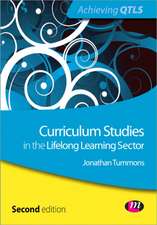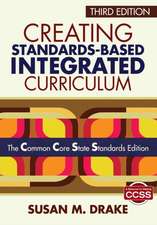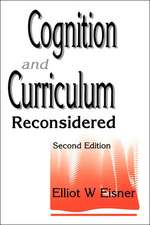50 Ways to Close the Achievement Gap
Autor Carolyn J. Downey, Betty E. Steffy-English, William K. Poston, Fenwick W. Englishen Limba Engleză Paperback – 17 noi 2008
provide assessments aligned to the curriculum;
align program and instructional resources to the curriculum and provide student equality and equity;
use a mastery learning approach and effective teaching strategies;
establish curriculum expectations, monitoring, and accountability;
institute effective district and school planning, staff development, resource allocations, and provide for a quality learning environment.
| Toate formatele și edițiile | Preț | Express |
|---|---|---|
| Paperback (1) | 348.72 lei 43-57 zile | |
| SAGE Publications – 17 noi 2008 | 348.72 lei 43-57 zile | |
| Hardback (1) | 598.92 lei 43-57 zile | |
| SAGE Publications – 17 noi 2008 | 598.92 lei 43-57 zile |
Preț: 348.72 lei
Nou
Puncte Express: 523
Preț estimativ în valută:
66.73€ • 69.86$ • 55.21£
66.73€ • 69.86$ • 55.21£
Carte tipărită la comandă
Livrare economică 07-21 aprilie
Preluare comenzi: 021 569.72.76
Specificații
ISBN-13: 9781412958981
ISBN-10: 1412958989
Pagini: 336
Dimensiuni: 178 x 254 x 21 mm
Greutate: 0.59 kg
Ediția:Third Edition
Editura: SAGE Publications
Colecția Corwin
Locul publicării:Thousand Oaks, United States
ISBN-10: 1412958989
Pagini: 336
Dimensiuni: 178 x 254 x 21 mm
Greutate: 0.59 kg
Ediția:Third Edition
Editura: SAGE Publications
Colecția Corwin
Locul publicării:Thousand Oaks, United States
Recenzii
"Each of the 50 strategies explains what the strategy is, why it is important, and how it can be implemented. This book will be a tremendous resource for educators."
"The strategies are a well-designed balance of central office support and site-based implementation that guides the educational leadership through curriculum alignment, mastery learning, and resource allocation in this age of NCLB accountability."
"The authors are the most knowledgeable in the field for quality improvement efforts in an era of high-stakes accountability. This resource will help practitioners maintain focus on the most important strategies for school improvement."
"A practical, easy-to-follow, but conceptually aligned book that identifies the things we can do to achieve substantial performance improvement in any school."
"A very timely and useful resource that offers clear and purposeful direction for those working in the field of student achievement."
"The strategies are a well-designed balance of central office support and site-based implementation that guides the educational leadership through curriculum alignment, mastery learning, and resource allocation in this age of NCLB accountability."
"The authors are the most knowledgeable in the field for quality improvement efforts in an era of high-stakes accountability. This resource will help practitioners maintain focus on the most important strategies for school improvement."
"A practical, easy-to-follow, but conceptually aligned book that identifies the things we can do to achieve substantial performance improvement in any school."
"A very timely and useful resource that offers clear and purposeful direction for those working in the field of student achievement."
Cuprins
Preface
Acknowledgments
About the Authors
Introduction
Six Standards for High-Performing Schools
1. Standard One: Establish a Well-Crafted, Focused, Valid, and Clear Curriculum to Direct Teaching
Strategy 1: Embed External Assessment Target Objectives in the Written Content Standards and Link to State Standards
Strategy 2: Have Clear and Precise District Curriculum Objectives - Content, Context, and Cognitive Type
Strategy 3: Deeply Align Objectives From External Assessments
Strategy 4: Sequence Objectives for Mastery Well Before They Are Tested
Strategy 5: Provide a Feasible Number of Objectives to Be Taught
Strategy 6: Identify Specific Objectives as Benchmark Standards
Strategy 7: Place Objectives in a Teaching Sequence
Strategy 8: Provide Access to Written Curriculum Documents and Direct the Objectives to Be Taught
Strategy 9: Conduct Staff Development in Curriculum and Its Delivery
2. Standard Two: Provide Assessments Aligned With the Curriculum
Strategy 10: Develop Aligned District Pre-Post Criterion-Referenced Assessments
Strategy 11: Have a Pool of Unsecured Test Items by Objective
Strategy 12: Establish Secured Performance Benchmark Assessments
Strategy 13: Conduct Assessment Training
Strategy 14: Use Assessments Diagnostically
Strategy 15: Teach Students to Be "Test Wise"
Strategy 16: Establish a Reasonable Testing Schedule and Environment
Strategy 17: Disaggregate Assessment Data
Strategy 18: Maintain Student Progress Reports
3. Standard Three: Align Program and Instructional Resources With the Curriculum and Provide Student Equality and Equity
Strategy 19: Align Programs With the Curriculum to Ensure Congruity
Strategy 20: Use Research Data That Document Results to Drive Program Selection, and Validate the Implementation of Programs With Action Research
Strategy 21: Evaluate Programs to Determine Their Effectiveness in Strengthening Student Achievement of Curriculum Objectives
Strategy 22: Align Textbooks and Instructional Resources With the District Curriculum Objectives and Assessment in Both Content and Context Dimensions
Strategy 23: Use Technology in Design or Selection Procedures to Ensure Strong Connections to System Learning Expectations and Feedback
Strategy 24: Provide Training in the Use of Instructional Resources and Their Alignment With System Curriculum Objectives - Content, Context, and Cognitive Type
Strategy 25: Select or Modify Instructional Resources for Lessons to Ensure Full Alignment With System Objectives and Tested Learning
Strategy 26: Place Students in Programs and Activities in an Equitable Manner and With Equal Access to the Curriculum
Strategy 27: Implement Effective Programs and Strategies With English Language Learners
4. Standard Four: Use a Mastery Learning Approach and Effective Teaching Strategies
Strategy 28: Implement a Mastery Learning Model
Strategy 29: Align Teaching With the Curriculum
Strategy 30: Provide Differentiated Curriculum and Instruction as Well as Differentiated Time to Learn
Strategy 31: Provide Practice to Master the Curriculum
Strategy 32: Use Effective Instructional Practices
Strategy 33: Use Powerful Vocabulary Development Strategies
Strategy 34: Establish Individual Learning Plans for Low-Achieving Students
5. Standard Five: Establish Curriculum Expectations, Monitoring, and Accountability
Strategy 35: Provide for High Expectations for Achievement for Each Student
Strategy 36: Monitor the Curriculum
Strategy 37: Visit Classrooms and Provide Follow-up
Strategy 38: Use Disaggregated Data in the Decision-Making Process
Strategy 39: Focus Staff Appraisal on Professional Growth
6. Standard Six: Institute Effective District and School Planning, Staff Development, and Resource Allocations, and Provide a Quality Learning Environment
Strategy 40: Develop a District Planning Process That Is Strategic in Nature and Provides Guidance for the Development of District and School Long-Range Plans
Strategy 41: Create and Implement a Singular, Focused, Multiyear District Plan That Incorporates Change Strategies for Higher Student Achievement
Strategy 42: Align School Plans With the District Plan
Strategy 43: Implement Aligned Teacher Training to Reach District and School Goals
Strategy 44: Implement Administrative Training Aligned With the Curriculum and Its Assessment and District Plan Priorities
Strategy 45: Provide Differentiated Staff Development
Strategy 46: Link Resource Allocations to Goals, Objectives, Priorities, and Diagnosed Needs of the System
Strategy 47: Provide Qualified and Adequate Personnel
Strategy 48: Remove Incompetent Staff or Help Them Achieve Satisfactory Functioning
Strategy 49: Provide a Quality Learning Environment
Strategy 50: Provide Quality Facilities
Summary
References
Index
Acknowledgments
About the Authors
Introduction
Six Standards for High-Performing Schools
1. Standard One: Establish a Well-Crafted, Focused, Valid, and Clear Curriculum to Direct Teaching
Strategy 1: Embed External Assessment Target Objectives in the Written Content Standards and Link to State Standards
Strategy 2: Have Clear and Precise District Curriculum Objectives - Content, Context, and Cognitive Type
Strategy 3: Deeply Align Objectives From External Assessments
Strategy 4: Sequence Objectives for Mastery Well Before They Are Tested
Strategy 5: Provide a Feasible Number of Objectives to Be Taught
Strategy 6: Identify Specific Objectives as Benchmark Standards
Strategy 7: Place Objectives in a Teaching Sequence
Strategy 8: Provide Access to Written Curriculum Documents and Direct the Objectives to Be Taught
Strategy 9: Conduct Staff Development in Curriculum and Its Delivery
2. Standard Two: Provide Assessments Aligned With the Curriculum
Strategy 10: Develop Aligned District Pre-Post Criterion-Referenced Assessments
Strategy 11: Have a Pool of Unsecured Test Items by Objective
Strategy 12: Establish Secured Performance Benchmark Assessments
Strategy 13: Conduct Assessment Training
Strategy 14: Use Assessments Diagnostically
Strategy 15: Teach Students to Be "Test Wise"
Strategy 16: Establish a Reasonable Testing Schedule and Environment
Strategy 17: Disaggregate Assessment Data
Strategy 18: Maintain Student Progress Reports
3. Standard Three: Align Program and Instructional Resources With the Curriculum and Provide Student Equality and Equity
Strategy 19: Align Programs With the Curriculum to Ensure Congruity
Strategy 20: Use Research Data That Document Results to Drive Program Selection, and Validate the Implementation of Programs With Action Research
Strategy 21: Evaluate Programs to Determine Their Effectiveness in Strengthening Student Achievement of Curriculum Objectives
Strategy 22: Align Textbooks and Instructional Resources With the District Curriculum Objectives and Assessment in Both Content and Context Dimensions
Strategy 23: Use Technology in Design or Selection Procedures to Ensure Strong Connections to System Learning Expectations and Feedback
Strategy 24: Provide Training in the Use of Instructional Resources and Their Alignment With System Curriculum Objectives - Content, Context, and Cognitive Type
Strategy 25: Select or Modify Instructional Resources for Lessons to Ensure Full Alignment With System Objectives and Tested Learning
Strategy 26: Place Students in Programs and Activities in an Equitable Manner and With Equal Access to the Curriculum
Strategy 27: Implement Effective Programs and Strategies With English Language Learners
4. Standard Four: Use a Mastery Learning Approach and Effective Teaching Strategies
Strategy 28: Implement a Mastery Learning Model
Strategy 29: Align Teaching With the Curriculum
Strategy 30: Provide Differentiated Curriculum and Instruction as Well as Differentiated Time to Learn
Strategy 31: Provide Practice to Master the Curriculum
Strategy 32: Use Effective Instructional Practices
Strategy 33: Use Powerful Vocabulary Development Strategies
Strategy 34: Establish Individual Learning Plans for Low-Achieving Students
5. Standard Five: Establish Curriculum Expectations, Monitoring, and Accountability
Strategy 35: Provide for High Expectations for Achievement for Each Student
Strategy 36: Monitor the Curriculum
Strategy 37: Visit Classrooms and Provide Follow-up
Strategy 38: Use Disaggregated Data in the Decision-Making Process
Strategy 39: Focus Staff Appraisal on Professional Growth
6. Standard Six: Institute Effective District and School Planning, Staff Development, and Resource Allocations, and Provide a Quality Learning Environment
Strategy 40: Develop a District Planning Process That Is Strategic in Nature and Provides Guidance for the Development of District and School Long-Range Plans
Strategy 41: Create and Implement a Singular, Focused, Multiyear District Plan That Incorporates Change Strategies for Higher Student Achievement
Strategy 42: Align School Plans With the District Plan
Strategy 43: Implement Aligned Teacher Training to Reach District and School Goals
Strategy 44: Implement Administrative Training Aligned With the Curriculum and Its Assessment and District Plan Priorities
Strategy 45: Provide Differentiated Staff Development
Strategy 46: Link Resource Allocations to Goals, Objectives, Priorities, and Diagnosed Needs of the System
Strategy 47: Provide Qualified and Adequate Personnel
Strategy 48: Remove Incompetent Staff or Help Them Achieve Satisfactory Functioning
Strategy 49: Provide a Quality Learning Environment
Strategy 50: Provide Quality Facilities
Summary
References
Index
Notă biografică
Carolyn J. Downey is professor emeritus of educational leadership in the College of Education at San Diego State University. She formerly was the superintendent for the Kyrene School District, Phoenix-Tempe, Arizona. Downey has written several books and numerous articles. She is the author of the training program "The Three-Minute Walk-Through and Reflective Feedback for Higher Student Achievement." Her most recent book with Betty E. Steffy, William K. Poston Jr., and Fenwick W. English is 50 Ways to Close the Achievement Gap. She was the major architect of the CMSI Individual School Audit using the 50 Characteristics for Higher Student Achievement. She is the author of several of the Principal-Teacher Series for Higher Student Achievement training materials. She received her MS from the University of Southern California and her PhD from Arizona State University.
Descriere
Written for school leaders, this completely revised edition outlines detailed, researched-based strategies for developing high-performing schools and fostering educational equity for all students.















